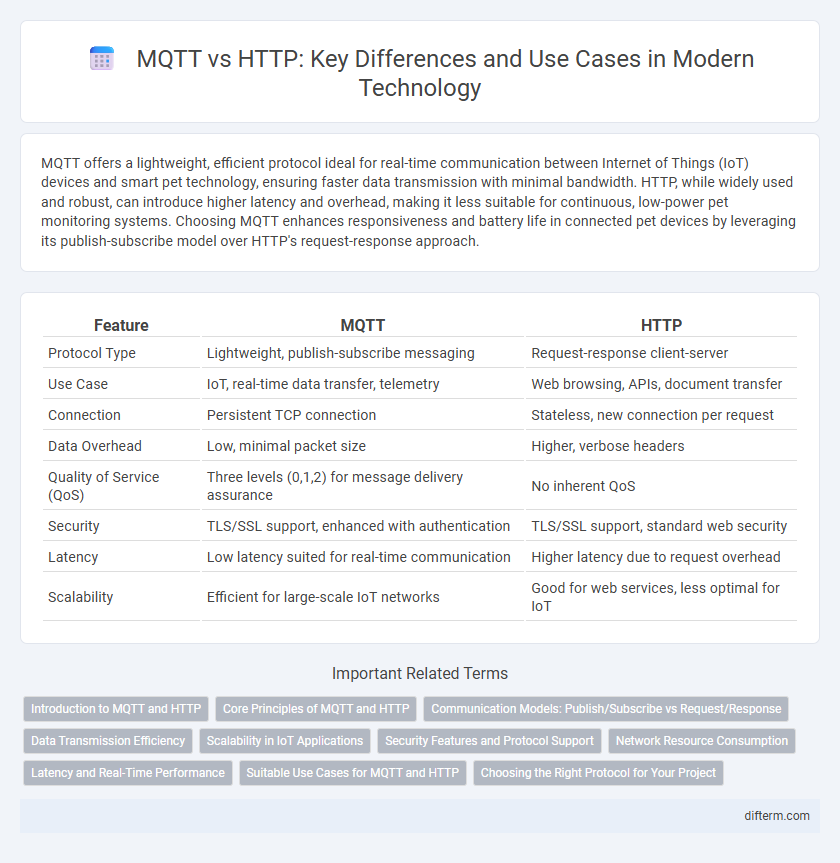MQTT offers a lightweight, efficient protocol ideal for real-time communication between Internet of Things (IoT) devices and smart pet technology, ensuring faster data transmission with minimal bandwidth. HTTP, while widely used and robust, can introduce higher latency and overhead, making it less suitable for continuous, low-power pet monitoring systems. Choosing MQTT enhances responsiveness and battery life in connected pet devices by leveraging its publish-subscribe model over HTTP's request-response approach.
Table of Comparison
| Feature | MQTT | HTTP |
|---|---|---|
| Protocol Type | Lightweight, publish-subscribe messaging | Request-response client-server |
| Use Case | IoT, real-time data transfer, telemetry | Web browsing, APIs, document transfer |
| Connection | Persistent TCP connection | Stateless, new connection per request |
| Data Overhead | Low, minimal packet size | Higher, verbose headers |
| Quality of Service (QoS) | Three levels (0,1,2) for message delivery assurance | No inherent QoS |
| Security | TLS/SSL support, enhanced with authentication | TLS/SSL support, standard web security |
| Latency | Low latency suited for real-time communication | Higher latency due to request overhead |
| Scalability | Efficient for large-scale IoT networks | Good for web services, less optimal for IoT |
Introduction to MQTT and HTTP
MQTT (Message Queuing Telemetry Transport) is a lightweight, publish-subscribe network protocol designed for constrained devices and low-bandwidth, high-latency environments, making it ideal for Internet of Things (IoT) applications. HTTP (Hypertext Transfer Protocol) operates as a request-response protocol primarily used for web communications, supporting resource retrieval and interaction over the internet. Both protocols serve different communication needs; MQTT excels in real-time, efficient messaging, while HTTP remains foundational for web data exchange.
Core Principles of MQTT and HTTP
MQTT operates on a lightweight publish-subscribe protocol designed for low-bandwidth and unreliable networks, optimizing message delivery with minimal headers and persistent session support. HTTP uses a stateless, request-response model primarily for web communications, relying on TCP for connection-oriented data exchange and extensive header information. MQTT's core principles emphasize efficient, real-time messaging in constrained environments, while HTTP focuses on robustness and broad compatibility across diverse internet applications.
Communication Models: Publish/Subscribe vs Request/Response
MQTT employs a publish/subscribe communication model enabling asynchronous, many-to-many message distribution through topics, ideal for IoT devices requiring efficient bandwidth and low latency. HTTP uses a request/response model based on synchronous client-server interactions, suitable for one-to-one communication with stateless transactions. The publish/subscribe architecture in MQTT enhances scalability and decouples producers and consumers, while HTTP's request/response offers simplicity and widespread compatibility.
Data Transmission Efficiency
MQTT uses a lightweight publish-subscribe protocol that minimizes packet overhead, making it highly efficient for constrained devices and low-bandwidth networks. HTTP relies on a request-response model with larger headers and stateless communication, which increases latency and bandwidth usage. In scenarios demanding real-time data transmission and reduced network consumption, MQTT outperforms HTTP in data transmission efficiency.
Scalability in IoT Applications
MQTT excels in scalability for IoT applications by using a lightweight publish-subscribe protocol that minimizes network bandwidth and device resource usage, making it ideal for large-scale deployments with constrained devices. HTTP, based on a request-response model, often struggles with overhead and latency when scaling to thousands of IoT endpoints due to its stateless nature and heavier message formats. Leveraging MQTT brokers enables efficient message distribution and real-time data updates, significantly improving scalability and responsiveness in IoT ecosystems compared to HTTP.
Security Features and Protocol Support
MQTT employs lightweight encryption and supports TLS/SSL for secure message transmission, making it ideal for IoT devices with constrained resources. In contrast, HTTP utilizes HTTPS with robust SSL/TLS protocols, offering widespread compatibility and strong security for web-based applications. MQTT's protocol supports persistent sessions and message QoS levels, enhancing reliable communication, whereas HTTP operates on a stateless request-response model limiting persistent connections and real-time data exchange.
Network Resource Consumption
MQTT significantly reduces network resource consumption compared to HTTP by using a lightweight messaging protocol that minimizes packet size and overhead. Its persistent TCP connection allows for efficient data transmission with lower latency and reduced bandwidth usage, especially beneficial for IoT devices with limited resources. HTTP relies on stateless, request-response cycles, resulting in higher data payloads and increased network traffic, which can strain constrained networks.
Latency and Real-Time Performance
MQTT offers significantly lower latency than HTTP due to its lightweight protocol and persistent TCP connection, enabling near real-time data transmission for IoT devices and messaging applications. HTTP relies on a request-response model, which introduces higher latency and is less efficient for continuous data streams. The publish-subscribe architecture of MQTT ensures faster message delivery and better real-time performance compared to HTTP's stateless nature.
Suitable Use Cases for MQTT and HTTP
MQTT excels in IoT environments requiring lightweight, low-bandwidth communication, such as real-time sensor data transmission and remote device management. HTTP is more suitable for web applications, including traditional client-server interactions, web page requests, and RESTful API calls where robust stateless communication and compatibility are essential. Choosing between MQTT and HTTP depends on the need for efficient, persistent messaging versus widespread protocol support and simplicity.
Choosing the Right Protocol for Your Project
MQTT offers lightweight, low-bandwidth communication ideal for IoT devices requiring real-time data transfer and efficient power usage, while HTTP provides robust, stateless request-response interactions suited for web-based applications with complex data needs. Selecting the right protocol depends on factors such as network reliability, message frequency, and device resource constraints. For projects demanding minimal latency and consistent connectivity, MQTT is preferable; HTTP excels when compatibility and widespread infrastructure support are priorities.
MQTT vs HTTP Infographic

 difterm.com
difterm.com